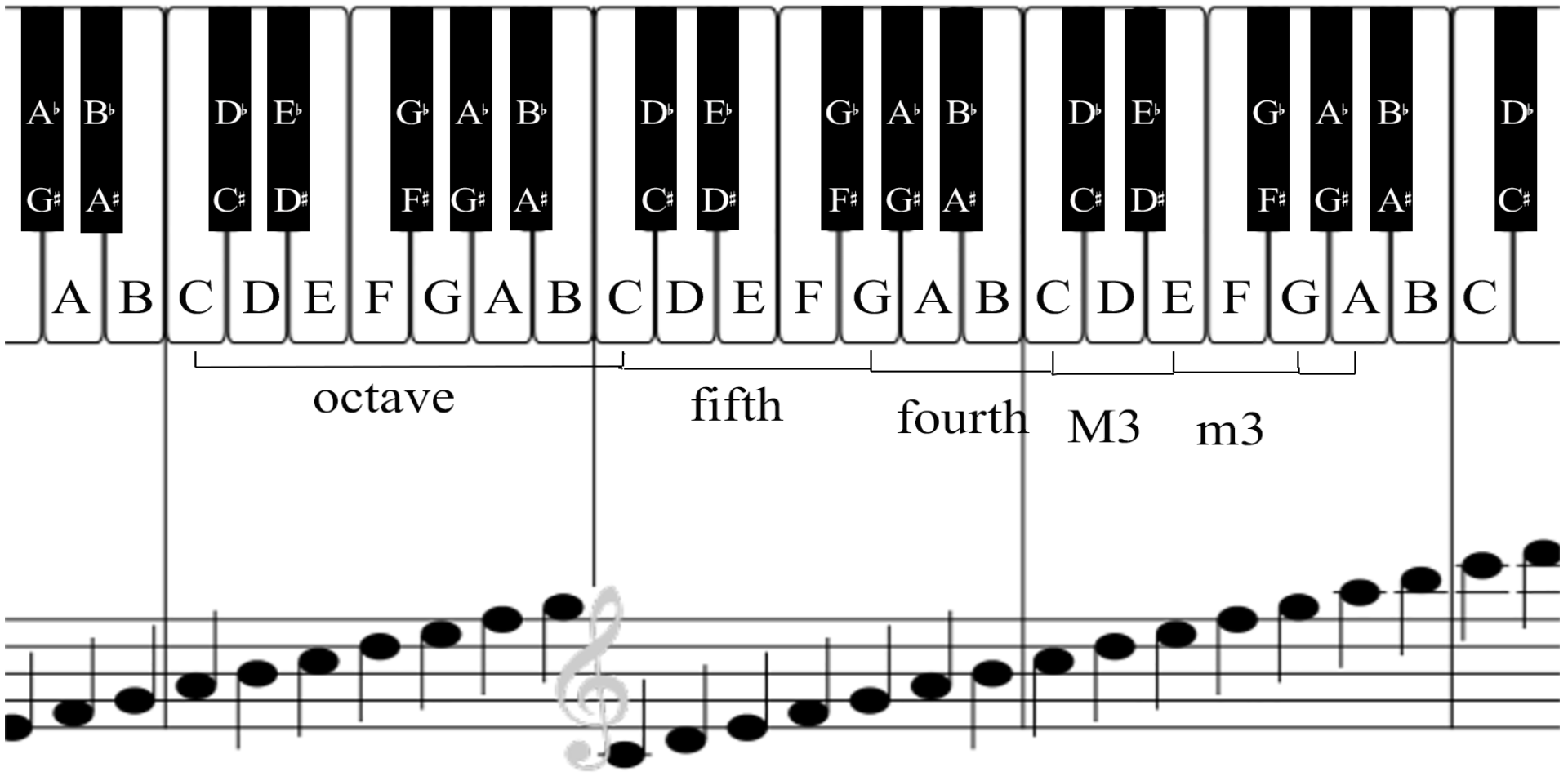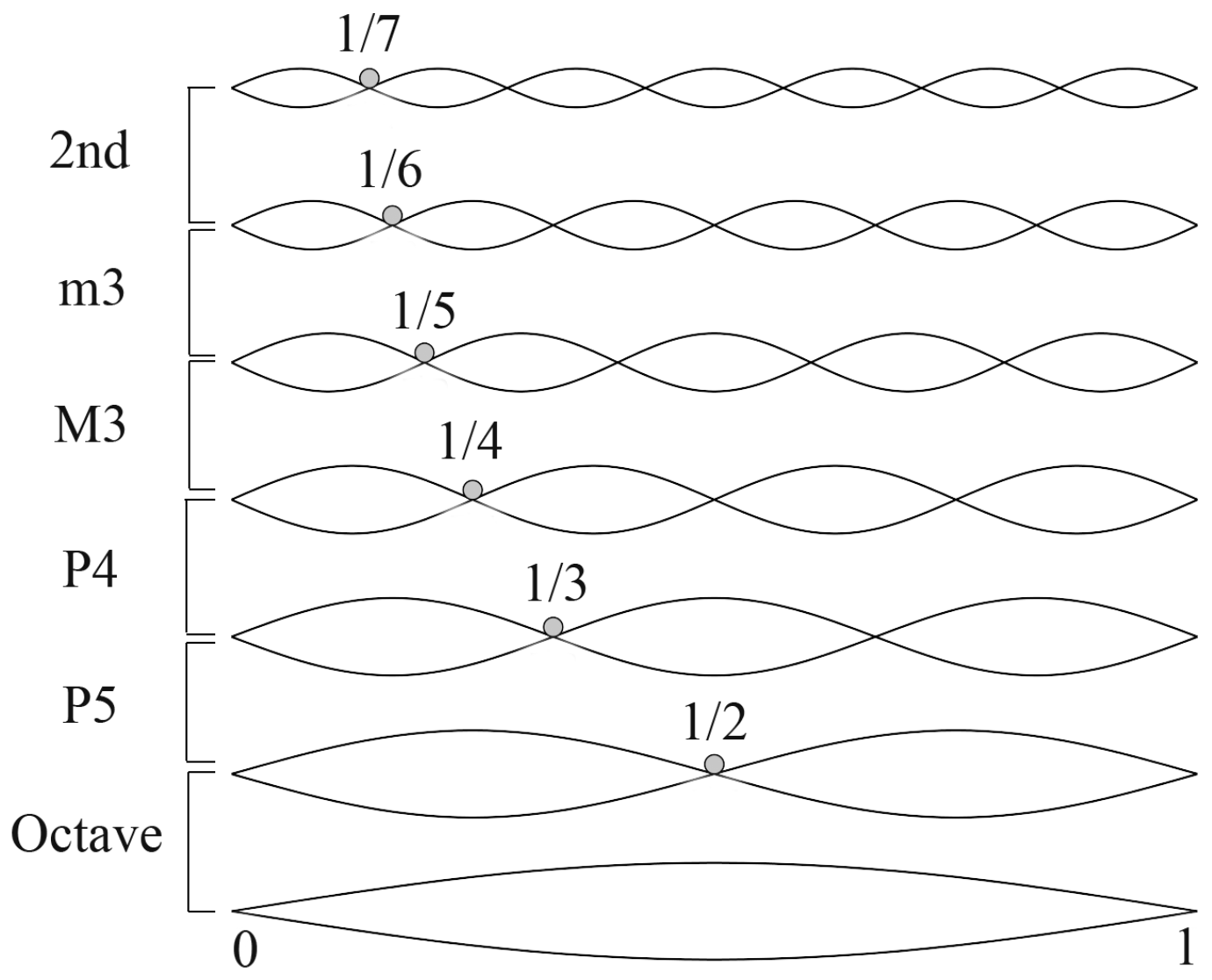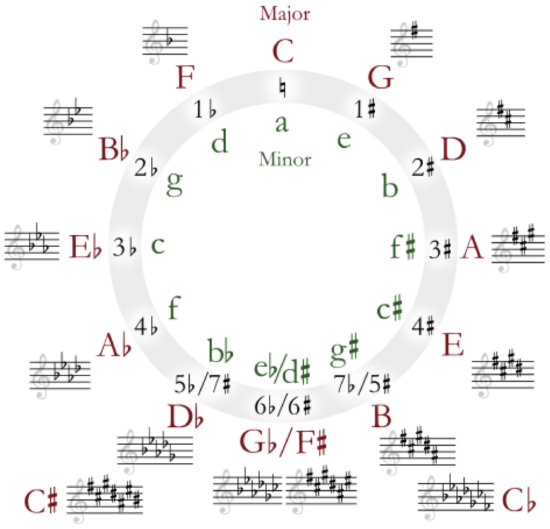4.1: Pitch
- Page ID
- 91144
Pitch in music refers to vibrations of sound waves. These vibrations are measured in hertz (cycles per second). Therefore a musical pitch is a sound produced at a certain number of cycles per second (Wade, 2013). The faster the vibration, the higher the resulting pitch. Likewise, the slower the rate of vibration, the lower the pitch. Musical tones can be divided into two categories: determinate and indeterminate pitch.
Musical pitches contain a mixture of sound waves. The one that dominates the sound is referred to as the “fundamental” pitch. All of the other waves that are produced by a pitch are referred to (in the music world) as overtones. When a pitch has a set of overtones that allow a fundamental note to dominate the sound it is a determinate pitch. Indeterminate pitch happens when the overtones of a note are not in alignment or there are conflicting fundamentals and therefore no “one” vibration dominates the sound. Another way to think about this concept is to know that instruments that have determinate pitch play notes that are typically given names (letter, number or solfege). Determinate pitch instruments include (but are not limited to): voice, piano, guitar, marimba, woodwinds, brass, chordophones, etc.... Indeterminate pitch instruments are instruments like gamelan gongs, snare drums, cymbals, triangle, etc... These instruments are generally used to keep a rhythm, to accent, or to add color.
When a pitch has a set of overtones that vibrate along with the fundamental in simple ratios (see Figure 2) then it makes a harmonic pitch. Most musical instruments that have determinate pitch are harmonic (chordophones, aerophones, most electrophones). When the overtones of the pitch are mostly inharmonic (not in simple ratios) then the pitch is discernable but the timbre is unique (timpani, mallet percussion, singing bowls, tuned gongs). Figure 2 illustrates the harmonic overtones. The wavelengths pictured also illustrate the possible notes that can be played on fixed length aerophones (bugle, bottle, conch shell, etc).
Tuning
Pythagoras of Samos (of the Pythagorean theorem) described why some musical notes vibrate well together (harmonize) and others do not. We use lengths of string to illustrate his findings. If two strings were physically proportioned in a 2 to 1 ratio (one string is exactly two times the length of the first) and all other factors are equal then the vibrations of musical notes produced by these strings will also exist in a 2 to 1 ratio. For instance: if the long string produced a pitch at 110 hertz then the shorter one would produce a pitch at 220 hertz. This 2 to 1 ratio is so harmonious that we call these two separate notes the same pitch name. The difference between two pitches of the same note name (or 2 to 1 ratio) is called an octave. Simply put and octave is the interval between two pitches having the same note name. A musical interval is the distance between two notes/pitches. In Figure 1 the distance between any two notes of the same letter name is called an octave.

This 2/1 octave ratio is also illustrated in Figure 2 in bottom two wavelengths.

All instruments are not tuned the same or even to the same pitch sets. When instruments are tuned to make the ratios scientifically pure (in the manner of Figure 2) this is called just intonation. While the ear prefers pure intervals they are not practical for much Western music. In the Western world most instruments are not tuned to just intonation. Instead, Western instruments are typically tuned to equal temperament. In equal temperament the octave is divided into twelve equidistant pitches. When this is done the purity of the scientific ratios is lost. This means that fixed pitch instruments like keyboards and guitars are not completely “in tune” according to just intonation. This “impure” tuning is necessary to play music that moves between differing scales/key areas. In Western music some genres of music utilize just intonation. This is primarily the case when instruments do not have fixed pitch (fretless chordophones from the violin family, human voice). Some genres that utilize scientific tuning/just intonation are barbershop harmony, choir music, and string quartets. Some highly produced modern pop and electronic dance music utilize just intonation. The computer is now used to produce much music that has “pure” intervals. Indian music also utilizes just intonation. Even though there are several fixed pitch and fretted instruments (like the sitar) used in Indian music intonation is not a problem because there is not movement between differing key areas.
In the Western world emphasis is placed on tuning to a standard pitch set. This allows musicians to play their instruments in differing genres and ensembles. The use of the piano in various genres illustrates this. Most American instruments are nowadays tuned to A 440 standard (A 442 in Europe and Asia). This is often referred to as “concert pitch”. In recording studios and music clubs digital tuners are used to help keep instruments in tune. These tuners can be clipped onto instrument, plugged into electrophones or downloaded to smartphones. Prior to the use of electronic tuners tuning forks and pitch pipes were common. Large acoustic ensembles typically tune together before playing music. In orchestras an oboe player plays “concert pitch” (A 440) for each section of instruments to match prior to the conductor “taking the podium.” Most instruments can make slight adjustment to either raise the pitch if it is too low (flat) or lower the pitch if it is too high (sharp). When all of the instruments have matched pitch (are in tune) then the concert begins. The act of playing many instruments causes them to go out of tune. Continual plucking or bowing of strings loosens the tension on them, making them go flat. Temperature and humidity also affect the pitch of many instruments. Brass and woodwind instruments tend to play sharp in hot weather and flat in colder conditions. This affects marching bands, which often perform in extreme weather conditions ranging from the hot sunshine of a late summer football halftime show to the cold air in a holiday parade.
In other cultures having a standard pitch is not prioritized. Where the pitch lies can depend on cultural norms. As Cathy Kiroe-Smith states in Musical Journeys, 2013, “In many African countries, for example, pitch is more of an approximation than a science and performers will play on instruments regardless of whether they are perfectly in tune with the instruments played by fellow performers or not.” In Indonesia each gamelan ensemble is tuned only in relation to the instruments within. This means that no two gamelan ensembles have the same tuning. Because of this individual instruments from one gamelan cannot be performed with another gamelan. This was also the case with traditional sikuri pan-pipes where communities would develop their own tuning. Contemporary siku pipes are often tuned to Western pitches. Other traditional instruments that are played alone are often not subjected to standardized tuning. This is true of solo flutes found around the globe. Church organs in Europe are tuned to a variety of concert pitches ranging from A 425 through A 456. Singers can make the adjustments to these pitches with ease while fixed pitch instruments like pianos, keyboard percussion, and fretted chordophones are limited in organs with which they could perform.
Intonation
Having a good sense of intonation means that one can recognize if a pitch is produced at the proper frequency. This is a skill that almost all can develop given time and practice. In American culture the term “tone deaf” is often applied incorrectly to one who has yet to develop a good sense of intonation. Tone deafness is a musical disorder called amusia. The opposite of tone deafness is perfect pitch. Perfect pitch is a rare condition through which someone having it can recognize exact vibrations without a reference. Researchers estimate that perfect pitch occurs in roughly 1 in 10,000 people (Sachs et al. 1995, 621). Instruments with indeterminate (drums) and/or fixed pitch (piano, guitar, computer) do not require development of intonation to the level of other instruments. Development of intonation takes much time and is part of the reason for the separation of string programs from wind, percussion, and choir programs in American schools.
Melody
Melody is a collection of pitches that are played in succession. Melody is often the focal point of the listener when experiencing music. Although there can be abstract melodies, in most genres melodies are a “tune” that is used to identify the piece of music. If you are going to tell someone about a song or piece that you heard you would probably start by singing the melody for them.
When listening to music with an ear for analysis of the melody the first step is to identify the instrument(s) that are performing it. In popular genres the melody is often the set of notes that are performed with lyrics by the human voice. In large ensembles the melody often shifts to differing instruments and timbre groupings. In some cases the melody is sung in harmony (or harmonized). This means that instruments play the melody at differing pitches but similar intervals and rhythms. The result is often chords/ harmony.
The second consideration when listening for melody is whether or not the melody is pre-composed or improvised. Improvisation is the process of composing and performing music at the same time. While some music is spontaneous invention (free jazz) most improvisation is the product of much disciplined training and practice (Bakan 2012, 29). Some genres (Jazz, Blues) have sections of melody that are improvised and others that are pre-composed. Another practice that often is improvised onto pre-composed melodies is ornamentation of the melody. Ornaments are cultural “decorations” of the melody in stylized ways by adding small twists, turns and extra notes to the melody. This is a common practice in Arab, Indian, East Asian, Celtic, and West African traditions.
Scales and Melodic Modes
The third consideration when analyzing melody is to consider what collection of pitches is in the melody. Most often melodies are built upon scales. A scale or melodic mode is a series of pitches that are presented in ascending and descending order. Scales are used to build musical pieces. When these scales hold more rules for performance and extra-musical associations they are called modes.
As mentioned above intervals are the distance between two musical notes. Some intervals are more important than others. This is because some intervals are more consonant/pleasing to the ear than others. The wavelengths in Figure 2 show a relationship moving upward away from consonance on the bottom. The octave is the most important interval. Next in importance are the “perfect” intervals of a fourth and a fifth. The Major third, the minor third and then Major second follow the perfect intervals. The most dissonant/least important intervals are the minor second and the tritone. In Western practice the octave is divided by twelve equal half-steps or minor seconds (also called semitones). On Figure 1 there are twelve notes between each pitch of the same letter name. When all twelve pitches are played in ascending and descending order it is called the chromatic scale. Because the chromatic scale contains only one interval (1⁄2 step) there is not sense of one note being more important than the others. This means that the chromatic scale is often used to express an un-settled or shifting quality.
Diatonic Major and Minor scales
The scales that are used for a majority of Western music are the two forms of the diatonic scale. Diatonic scales are seven note scales that contain a series of whole and half steps. Because they have differing intervals there is a home pitch that is the resting pitch or “home” pitch within the scale. This note is called the tonic. In the C diatonic scale the note C is the tonic pitch. Diatonic scales can be built on all twelve notes as the tonic. There are two forms of the diatonic scale called diatonic major and diatonic minor. They each consist of a series of whole and half steps as illustrated in Figure 3. One whole step equals two half steps.

The melodies of most songs in the Western tradition are built using the notes of the major or minor scales. Generally the notes of the major scale are culturally understood to sound “happy” or “light” while the notes of the minor scale sound “sad” or “down”. If one plays all of the white keys (naturals) of a piano from C to C then it will be a C major scale. C Major is the only major scale that can be played without playing the accidentals (black keys). Likewise the A minor scale is played on all of the naturals from A to A. Figure 4 gives all of the major and minor keys with corresponding key signatures (number of sharps or flats).

By Just plain Bill (Own work) [GFDL (http://www.gnu.org/copyleft/fdl.html) via Wikimedia Commons
There is a hierarchy of pitches in each scale. The most important pitch is the first scale degree and is called tonic. The dominant pitch is the second most important pitch. It is the fifth diatonic scale degree. Sub-dominant is built on the fourth scale degree and is also considered important.
When referring to pitches it is standard now in the west to use letter names. Traditionally most cultures use some system of solfege. Solfege uses syllables to name pitches in relation to scales. In the western diatonic major scale the solfege syllables are do, re, mi, fa, sol, la, ti, do with the tonic note being do. The advantage of learning solfege is that singers can sing the same melody in all keys without adjusting the note names.
Pentatonic Scale
The pentatonic scale is a scale that has been used by many cultures. The pentatonic scale has five notes. The minor form of this scale has a minor 3rd, whole step, whole step, minor 3rd, whole step. This scale can be played on all of the black keys of a piano starting and ending on E-flat. The major form of this scale contains the notes of a major diatonic scale without the fourth and the seventh scale degrees. In differing forms the pentatonic scale is utilized as a primary scale in much sub- Saharan African music, far-East Asian music, and Gamelan music from Indonesia. The gamelan systems of tuning pelog and slendro utilize pentatonic scales that have nothing to do with the Western division of the octave.
Blues Scale
The most common blues scale is a minor pentatonic scale with an added note. This scale can be played over any chord in a “blues chord progression”. This makes it essential to both the blues and jazz genres. See figure 5.



